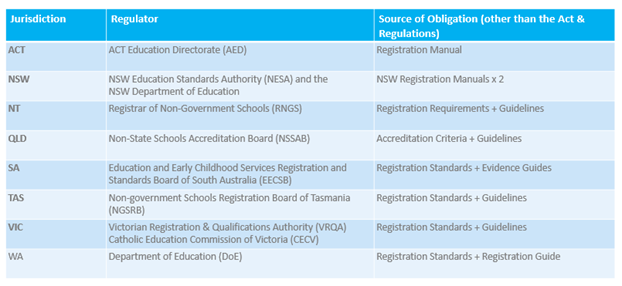This is the first article in a three part series on Registration 'Pain Points' for Schools. You can access part 2 here and part 3 here.
As a school leader and a school director, I have been personally involved in many re-registration audits. They were usually time consuming, hard work and, generally, quite stressful for all involved. Why? Because, generally speaking, in the years leading up to the re-registration audit, the school had not worked towards ongoing compliance. We had done the opposite of what we sought to train our students to do in relation to exams and assignments. We had often ‘left everything to the last minute’. We were so busy on a day-to-day basis dealing with the education and safety of our students that sometimes, unless we had a dedicated risk and compliance person on staff, the ongoing compliance was shuffled down the list of pressing jobs.
However, and I think it’s imperative to state this up front, I do not consider school and school governing body accountability to the regulators to be a bad thing. I believe that schools and their governing bodies must be ultimately accountable for the safety of all students and staff and for the standard of education of the children. I also believe that schools should be held accountable for the use of government funds (e.g. per capita), parent fees, compliance (both registration and legislation), enterprise risk management, sound financial management practices, teaching and learning facilities and, above all, for their own culture and their religious or educational ethos.
Therefore, although registration may be a process that schools often face with a sense of dread, it is here to stay and it ensures that schools are held accountable for delivering what they promise to provide to their students and parents.
Who Are the Regulators?

Each jurisdiction in Australia has its own regulator that manages the registration of all non-government schools in that state or territory. In all states and territories, the relevant Education Acts require non-government schools to be registered or provisionally registered before operating as a school.
The sources of obligation are always the relevant Education Act and Regulations, and these are distilled further via registration standards, manuals, guides or guidelines.
The re-registration process also varies from jurisdiction to jurisdiction. It generally involves some form of a desktop audit of policies and other controls such as WWCC staff lists and teacher registration details and then, in most cases, an onsite visit to tour the school. In Western Australia, for example, the onsite visit includes meeting and interviewing members of the board and the school community.
The Issues and Pain Points
The registration standards, manuals, guides or guidelines in most states and territories set out the evidence and other requirements of compliance that the regulators expect to sight during a school’s re-registration process.
The regulators also tend to update their requirements either annually or at least every two to three years. This means that schools that go through re-registration and are given a set term of registration (usually up to five years) often find that they are no longer compliant by their next re-registration if they have not kept on top of any new or changed requirements in their jurisdiction’s registration manual since their last re-registration.
This is because, in some schools, their policies often languish in ‘staff information files’ (hard copy or PDF) and basically ‘sit on the shelf’ between re-registration audits. It is almost a situation of complete, pass, accept and forget- until it all comes around again.
This then leads to a mad scramble by schools in what I have heard described as the “re-registration nightmare”. Here are a few ‘quotable quotes’:
- “We can’t do it the same way next time!”
- “This took so much time, money and people!”
- “Our systems are not what they should be
- if we are to make it easier next time.”
- “We need some sort of tech and content combination if we are to make it easier.”
- “It feels like we just go back to scratch every time.”
Schools that are going through re-registration will also often ask the following questions:
- “Have the standards changed since the last time we looked at them or went through re-registration?” This is what I hear a lot especially from schools that have a complete, pass, accept and forget mentality - until it all comes around again.
- “Do we understand exactly what the standard requires of us regarding evidence?”
- “Will the assessors (auditors) have a different interpretation than ours? If so, what will happen?”
- “Who will the assessors want to meet and/or interview?”
- “How much evidence do we need to show that we are compliant with this standard?”
- “Have we met all the standards? Are there any that are not applicable to us?”
- “What do we do if we do not have the evidence needed to meet all of the standards?” This is the part of re-registration that involves the most angst and work - putting together ‘risk controls’ (policies or other documents) that you do not have because you missed a change in the standards.
- “Who will do the work required to get all of the evidence together?”
- “Who will write the relevant policies or create the tables etc that we need to show evidence of compliance?”
- And finally … “How much time will this take?” Schools that are ‘on top of registration’ often start this process up to six months before both the desktop audit and the auditors’ visit. Those that leave it too late end up scrambling to get ready.
What Should Schools Be Doing?
Basically, schools need to understand that the regulators are not toothless. They need to see that you are compliant with the standards as a minimum (and rightly so), or they can:
- refuse to renew a school’s registration
- refuse an application for a registration change
- impose or change a condition
- give a direction
- cancel the registration of a school.
So, what do schools need to do if they are coming up for re-registration?
- Not just have policies- these days you need to prove that you have implemented all of the required policies OR are demonstrating to the regulators your evidence of compliance with the standard. Just having the policies is no longer enough
- Focus on good governance – this leads to better run schools, better use of resources and better decision making and therefore better outcomes for everyone. More specifically:
a. risk management is considered to be increasingly important at all levels – many school regulators are making this risk-based approach requirement explicit
b. financial governance - there’s increased scrutiny of the use of public funds – the regulators want to know that you are spending your per capita funding in a manner that meets both the requirements of the Australian Education Act but also jurisdictional requirements. Basically, schools are now expected to have what I would call ‘normal corporate governance financial requirements’ such as documented financial decision making, external auditing, transactions at market value, disclosing and recording conflicts of interest, related party transactions etc
c. full financial auditing for compliance where there are regulator concerns
- Show evidence that your school meets the requirements not only of the regulators but also of external bodies such as the ACNC (e.g. Not for Profit and Governance Standards) and the ATO
- Have detailed record keeping for everything
- Have procedures for everything (the who, how, when, where and what)-these must be contextualised for the school (not copied from somewhere else!)
- Expect the increasing use of board chair or principal attestations / legal confirmation (such as in the ACT, NSW and WA)
- Demonstrate continuous compliance not once every registration cycle- in some jurisdictions such as NSW, this includes random auditing.
Schools should anticipate the above requirements and expectations by proactively implementing internal registration compliance systems that:
- are responsive to regulatory change
- facilitate continuous compliance by all school staff
- meet the expectations and needs of their state/territory registration authority and its assessors/auditors.
.png?width=6000&name=SES%20Webinar%20Ad%20(1).png)



.png?width=6000&name=SES%20Webinar%20Ad%20(1).png)

